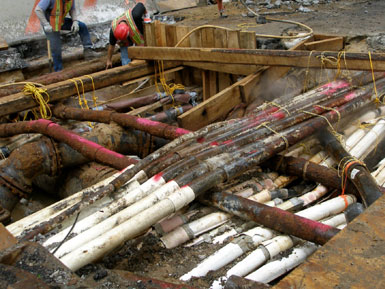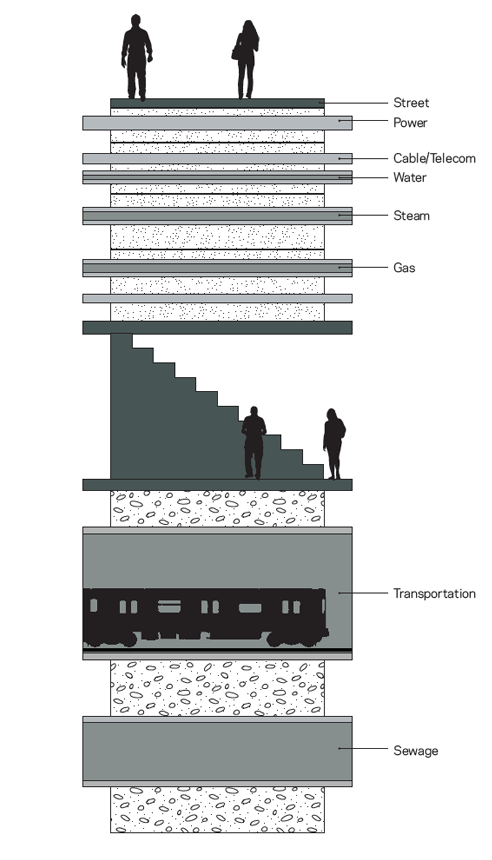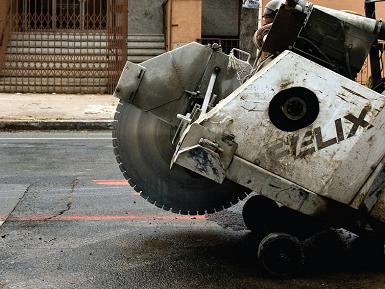2.0 Advance Notice & Coordination
Advance notice and coordination of planned street work is one of the most effective tools for reducing the number of street excavations, especially on streets that are scheduled to be resurfaced or reconstructed. Street excavators, including utility companies and developers, can access New York City Department of Transportation (NYC DOT) data and attend NYC DOT coordination meetings to facilitate effective communication regarding planned street work.
About this Chapter
Thousands of miles of utility pipes, cables and other equipment are beneath the streets of New York City. The installation and repair of this infrastructure is crucial to maintaining and strengthening the city's competitive position in the global economy. Inevitably, street excavations to install or access this infrastructure disrupt the normal activity of New York's streets, causing frustration and confusion for local residents and businesses. Street excavations also adversely affect the condition of the streets, reducing the number of years the pavement would otherwise be expected to remain in good or excellent condition following resurfacing or reconstruction, and increasing repair and life cycle costs for the city.
The goal of advance coordination is to reduce the number of excavations in New York City streets. To this end, this chapter discusses existing mechanisms that help inform utility companies and other potential street excavators of impending NYC DOT work, including how to access information on NYC DOT's planned capital projects, weekly street resurfacing schedules, "protected street"* information and other data that can help to facilitate effective communication regarding street work. It also outlines principles for coordinating with NYC DOT when proposing excavation work to help make certain that excavation on streets occurs before or in conjunction with city street work, where practicable.
NYC DOT project locations, protected streets, and other maps are available online at the Department of Information Technology & Telecommunications (DoITT) NYCityMap website and the DOTMap portal. Permittees can use these maps to make informed decisions while planning new projects.
2.1 The Goal of Advance Notice and Coordination
Advance notice and coordination of planned street work is one of the most effective tools for reducing the number of street excavations on newly resurfaced or reconstructed streets. With advance notice of proposed excavation work, NYC DOT can sequence the timing of the large number of roadway and utility works being undertaken across the city. Similarly, the sooner a potential street excavator knows about NYC DOT's intent to work in a particular location, the better it can make arrangements to avoid or reduce potential conflicts.

New York City streets include a complex mix of assets such as electric, gas, telephone, cable, water, sewer and steam lines, requiring coordination among the different asset owners when street work is performed.
2.2 NYCityMap, DOTMap, and Other Online Information
With advance notice of NYC DOT's intent to work in a particular location, utility companies and other potential street excavators are better able to make arrangements to minimize potential conflicts or to leverage the opportunity to perform their work before resurfacing or reconstruction is complete. In order to assist the goal of advanced coordination, information about planned NYC DOT projects is available via the DOTMap portal within the NYCityMap website. By accessing this map portal, a utility company or any other entity that performs street excavation work can find details on NYC DOT projects included in the city's 10-year Capital Budget, as well as more imminent NYC DOT and New York City Department of Environmental Protection capital projects currently in design or under construction.

NYCityMap is the city's web-based interactive mapping application. It includes capital construction projects.
View information on how to navigate and use NYCityMap.
DOTMap also features a protected streets layer, enabling utilities and other potential street excavators to view which streets are protected and for what period of time. The protected streets layer is current as of the previous business day. The screen image below displays the "NYC DOT 10 year Capital Plan" projects in green and protected streets in blue.
Clicking on the "i" button at the top center of the map will change the cursor into an arrow with an "i" next to it. With this cursor, users can click on the map to get information about a particular map layer. As shown in the screen image, the pop-up for the "NYC DOT 10 year Capital Plan" layer features a project ID, title, and the fiscal year for which the project is planned, whereas the pop-up for "NYC DOT Protected Streets" includes street name and the date to which protected status extends.
Other Online Information
Weekly Milling and Resurfacing and Concrete Repair Schedules—NYC DOT weekly milling and resurfacing schedules are available online.
The milling and resurfacing schedules are organized by borough and are sent electronically each week to utility companies and other city agencies. A longer-term resurfacing schedule that forecasts several months of anticipated work is distributed during borough-level monthly utility coordination meetings (see Section 2.3 Key Principles for Effective Notice and Coordination of Planned Street Work). NYC DOT's concrete repair schedule for roadways, sidewalks and other assets in the street can also be accessed from this link.
Embargoes—NYC DOT imposes construction "embargoes" (a temporary suspension of active permits in the affected area) for significant special events including the New York City Marathon, parades, high profile projects and the winter holiday season. Click here for a list of current construction embargoes. Additional information regarding embargo periods is provided in Chapter 3, Section 3.6.2.
2.3 Key Principles for Effective Notice and Coordination of Planned Street Work
NYC DOT is working to enhance the coordination of major planned work that impacts the streets with utility companies and other entities that perform street excavations. To this end, NYC DOT has dedicated time and resources to enhance its own systems and coordination efforts. It is important that contractors and utility companies are responsible partners as well in order for coordination to be effective. Coordinating street work in accordance with the principles of this section will help to minimize delays and disruption to road users, businesses and residents and help extend the useful life of city streets.

Key principles for effective coordination include:
Provide Notice of Planned Street work at Earliest Opportunity—The basic principle of providing adequate advance notice is the greater the disruption, the longer the notice period needed.
The notice provisions specified in Section 2-02(g) of the Highway Rules are the minimum required for street operations. Click here to access the Highway Rules
By mutually sharing data before detailed construction plans have been developed NYC DOT and street excavators can adjust their project plans to avoid conflict and maximize the potential opportunity for street work coordination.
Share long-term capital plans for planned repairs, upgrades and new
service—Information on long-term capital programs from potential street excavators helps NYC DOT to effectively coordinate planned street work. It also helps NYC DOT to identify opportunities for joint bidding and to coordinate the timing of the agency's resurfacing and reconstruction activities.
Regular Input and Attendance of Decision Makers at Coordination
Meetings—Regular coordination meetings allow decision makers to share information and to discuss project difficulties and constraints. Several forums are in place to provide advance notice of city capital projects. NYC DOT hosts borough-level meetings to discuss the scheduling of upcoming resurfacing projects with utility companies and other potential street excavators. NYC DOT also routinely meets with utility companies and others who perform street excavations to inform these organizations of upcoming events and major construction projects with which NYC DOT is involved. Additionally, in the middle of each fiscal year, the New York City Department of Design and Construction (DDC) convenes a meeting with other agencies and utilities to discuss city projects under its purview that are expected to begin construction during the next four years. During the final design stage of a city project, DDC will also hold a series of alignment meetings with the utilities and other agencies to inform them about proposed changes to the location of street infrastructure that would require facility relocation.

Coordination aims to reduce street excavation work on recently repaved streets.